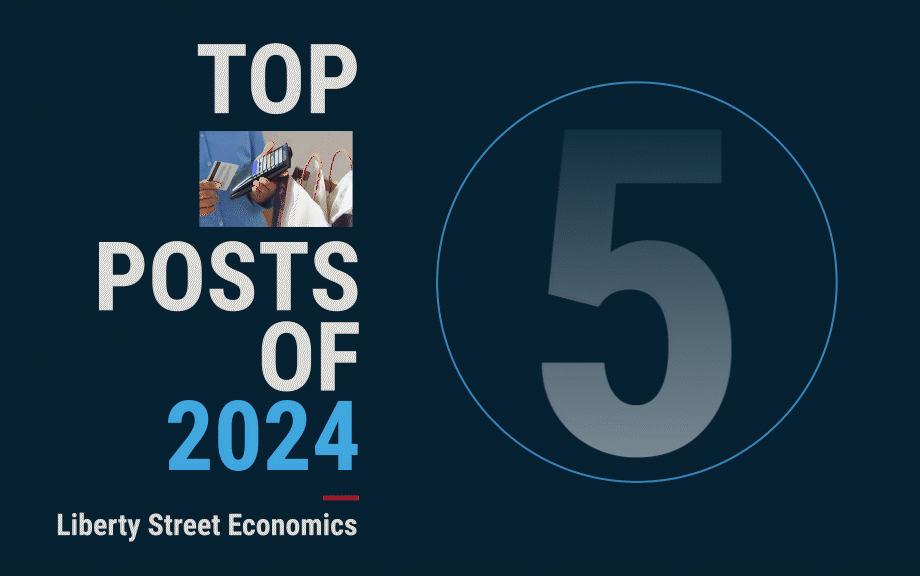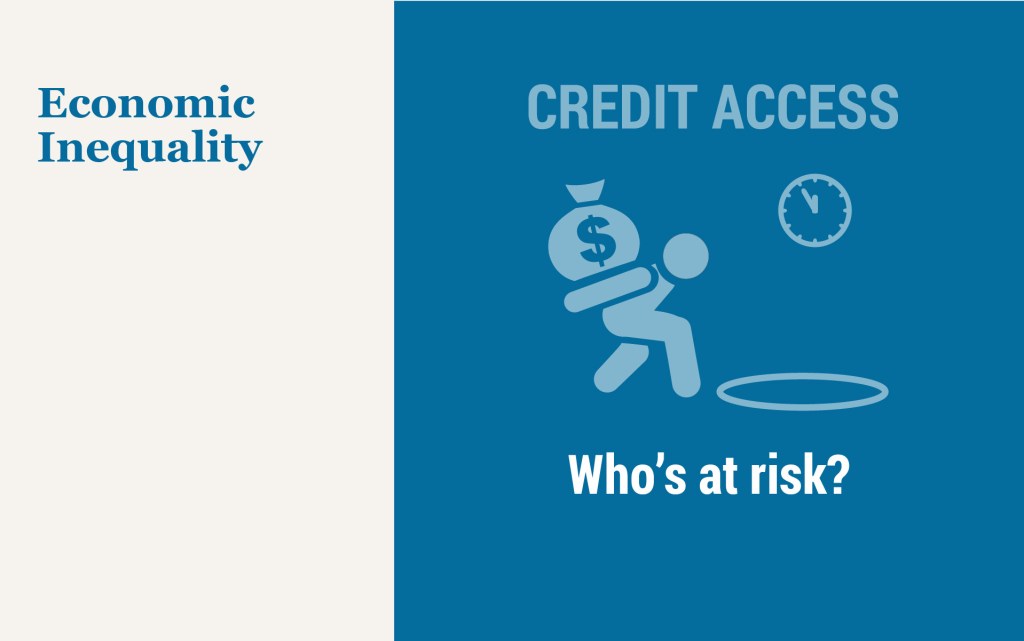Why Are Credit Card Rates So High?

Credit cards play a crucial role in U.S. consumer finance, with 74 percent of adults having at least one. They serve as the main method of payment for most individuals, accounting for 70 percent of retail spending. They are also the primary source of unsecured borrowing, with 60 percent of accounts carrying a balance from one month to the next. Surprisingly, credit card interest rates are very high, averaging 23 percent annually in 2023. Indeed, their rates are far higher than the rates on any other major type of loan or bond. Why are credit card rates so high? In our recent research paper, we address this question using granular account-level data on 330 million monthly credit card accounts.
Kartik Athreya on His First Year as Research Director of the New York Fed
Breaking Down Auto Loan Performance

Debt balances continued to rise at a moderate pace in the fourth quarter of 2024, and delinquencies, particularly for auto loans and credit cards, remained elevated, according to the latest Quarterly Report on Household Debt and Credit from the New York Fed’s Center for Microeconomic Data. Auto loan balances have grown steadily since 2011, expanding by $48 billion in 2024. This increase reflects a steady inflow of newly originated auto loan balances, which in 2024 were boosted primarily by originations to very prime borrowers (those with credit scores over 760) while originations to borrowers with midprime and subprime scores held roughly steady. In this post, we take a closer look at auto loan performance and find that delinquencies have been rising across credit score bands and area income levels. We also break down auto loan performance by lender type and find that delinquencies are primarily concentrated in loans from non-captive auto finance companies.
Every Dollar Counts: The Top 5 Liberty Street Economics Posts of 2024

High prices and rising debt put pressure on household budgets this year, so it’s little wonder that the most-read Liberty Street Economics posts of 2024 dealt with issues of financial stress: rising delinquency rates on credit cards and auto loans, the surge in grocery prices, and the spread of “buy now, pay later” plans. Another top-five post echoed this theme in an international context: Could the U.S. dollar itself be under stress as central banks seemingly turn to other reserve currencies? Read on for details on the year’s most popular posts.
Mortgage Lock‑In Spurs Recent HELOC Demand

Mortgage balances, the largest component of U.S. household debt, grew by only $77 billion (0.6 percent) in the second quarter of 2024, according to the latest Quarterly Report on Household Debt and Credit from the New York Fed’s Center for Microeconomic Data. This modest increase reflects a substantial slowdown in mortgage origination; only $374 billion was originated during the second quarter, compared to an average of about $1 trillion per quarter between 2021 and 2022. Meanwhile, after nearly thirteen years of decline, balances on home equity lines of credit (HELOC) have begun to rebound, gaining 20 percent since bottoming out at the end of 2021. In this post, we consider the factors behind this upswing, finding that HELOCs have likely become an attractive alternative to cash-out refinancings amid higher interest rates.
Delinquency Is Increasingly in the Cards for Maxed‑Out Borrowers

This morning, the New York Fed’s Center for Microeconomic Data released the Quarterly Report on Household Debt and Credit for the first quarter of 2024. Household debt balances grew by $184 billion over the previous quarter, slightly less than the moderate growth seen in the fourth quarter of 2023. Housing debt balances grew by $206 billion. Auto loans saw a $9 billion increase, continuing their steady growth since the second quarter of 2020, while balances on other non-housing debts fell. Credit card balances fell by $14 billion, which is typical for the first quarter. However, an increasing number of borrowers are behind on credit card payments. In this post, we explore the relationship between credit card delinquency and changes in credit card “utilization rates.”
An Update on the Health of the U.S. Consumer

The strength of consumer spending so far this year has surprised most private forecasters. In this post, we examine the factors behind this strength and the implications for consumption in the coming quarters. First, we revisit the measurement of “excess savings” that households have accumulated since 2020, finding that the estimates of remaining excess savings are very sensitive to assumptions about measurement, estimation period, and trend type, which renders them less useful. We thus broaden the discussion to other aspects of the household balance sheet. Using data from the New York Fed’s Consumer Credit Panel, we calculate the additional cash flows made available for consumption as a result of households’ adjustments to their debt holdings. To detect signs of stress in household financial positions, we examine recent trends in delinquencies and find the evidence to be mixed, suggesting that certain stresses have emerged for some households. In contrast, we find that the New York Fed’s Survey of Consumer Expectations still points to a solid outlook for consumer spending.
Who Uses “Buy Now, Pay Later”?

“Buy now, pay later” (BNPL) has become an increasingly popular form of payment among Americans in recent years. While BNPL provides shoppers with the flexibility to pay for goods and services over time, usually with zero interest, the Consumer Financial Protection Bureau (CFPB) has identified several areas of potential consumer harm associated with its growing use, including inconsistent consumer protections, and the risk of excessive debt accumulation and over-extension. BNPL proponents have argued that the service enables improved credit access and greater financial inclusion, with approval being quick and relatively easy. More research is needed to assess the overall risks and benefits of BNPL for consumers. As a first step, we draw on new survey data to examine the background and circumstances of consumers who receive and take up BNPL offers. We find both the availability and use of BNPL to be fairly widespread but see disproportionate take-up among consumers with unmet credit needs, limited credit access, and greater financial fragility. While BNPL expands financial inclusion, especially to those with low credit scores, there is a risk that these payment plans contribute to excessive debt accumulation and over-extension.
Not Just “Stimulus” Checks: The Marginal Propensity to Repay Debt

Households frequently use stimulus checks to pay down existing debt. In this post, we discuss the empirical evidence on this marginal propensity to repay debt (MPRD), and we present new findings using the Survey of Consumer Expectations. We find that households with low net wealth-to-income ratios were more prone to use transfers from the CARES Act of March 2020 to pay down debt. We then show that standard models of consumption-saving behavior can be made consistent with these empirical findings if borrowers’ interest rates rise with debt. Our model suggests that fiscal policy may face a trade-off between increasing aggregate consumption today and assisting those with the largest debt balances.
Car Prices Drive Up Borrowing

Total household debt increased substantially during the second year of the COVID-19 pandemic, with a $1.02 trillion increase in aggregate debt balances, according to the Quarterly Report on Household Debt and Credit for the fourth quarter of 2021 from the New York Fed’s Center for Microeconomic Data. The yearly increase was the largest seen since 2007 in nominal terms and was boosted by particularly robust growth in mortgage balances, which grew by nearly $900 billion through 2021. Credit card balances, which have followed an unusual path during the pandemic, saw a large seasonal increase in the fourth quarter but remain well below pre-pandemic levels. And student loan balances increased only modestly through 2021 due to lower enrollment and also due to administrative forbearance on federal student loans—the smallest annual increase we’ve seen since 2004. Outstanding auto loan balances grew in 2021 by $84 billion. The $734 billion in newly opened auto loans through the year was the largest volume we’ve seen in our data.











 RSS Feed
RSS Feed Follow Liberty Street Economics
Follow Liberty Street Economics